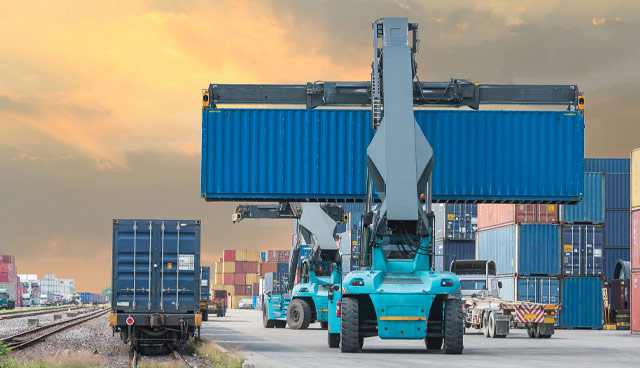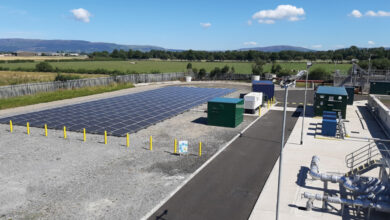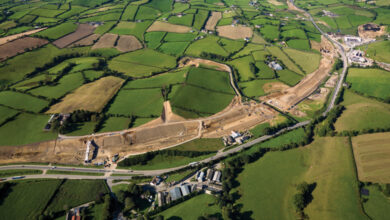Northern Ireland’s export value rising

The Freight Transport Association’s (FTA) Logistics Report 2019 has found that Northern Ireland’s export value rose in 2018, but that the region remained the UK region with the lowest export value. With uncertainty permeating, the report also examined variances in trade with the Republic of Ireland across what would be the EU’s only land border post-Brexit.
The report, which “sets out how logistics is performing on key measures and the events and trends that are currently shaping it”, found that Northern Ireland’s export value had risen to £8.87 billion in 2018, a 1.9 per cent rise from 2017. However, this was far and away the lowest export value of any UK region, with the next lowest being England’s North East, which recorded an export value of £13.16 billion.
Northern Ireland’s rise was also the joint smallest rise of those regions that did experience one; the 1.9 per cent was mirrored by the North East. Two regions – England’s West Midlands and the East of England – did suffer falls in their export values, but still recorded figures of £33.37 billion and £28.23 billion respectively.
This gap from the rest of the UK market could be explained by the much lower numbers of logistics enterprises and the lower proportion of employees in the region being logistics employees. The report counts 5,220 logistics enterprises in Northern Ireland, with them accounting for 2 per cent of the region’s employees; only the North East has a smaller amount of enterprises, with 4,070. Scotland, in contrast, has 9,410 logistics enterprises accounting for 9 per cent of employees.
Trade with the Republic of Ireland was found to have accounted for £14 billion of imports and £21.1 billion of exports for the UK as a whole. Of the powered vehicles registered in the UK travelling to Europe in 2018, 23.8 per cent travelled directly to the Republic of Ireland. There was also a 1.9 per cent increase in the number of vehicles travelling from Great Britain to either the Republic of Ireland or Northern Ireland, with the figure rising to 883,000.
These figures include 365,000 powered vehicles, a 2.2 per cent decrease from 2017. 219,000 of these vehicles disembarked in the Republic of Ireland, with the remaining 146,000 disembarking in Northern Ireland. 519,000 of the 883,00 vehicles were unaccompanied trailers, a 4.9 per cent increase from 2017. Again, the majority of these disembarked in the Republic of Ireland, although the gap was significantly smaller, with 265,000 in the Republic and 256,000 in Northern Ireland.
Of all the vehicles travelling from Great Britain to the island of Ireland, 78.8 per cent were registered in either Ireland or the UK. 37.8 per cent of vehicles disembarked in the Republic of Ireland were UK registered, with 29.1 per cent carrying Irish registration. However, there is much greater disparity when it comes to vehicles disembarked in Northern Ireland, where 89.8 per cent of vehicles disembarked held UK registration and just 7 per cent held Irish registration.
The report also contains findings of the FTA’s annual Logistics Industry Survey, which covers 500 businesses across 15 sectors both in the UK and further afield. Through this, it is reported that the EU “is the UK’s largest international shipping trade route constituting 54.6 per cent of the 481.8 million tonnes of freight that passed through the UK’s major ports in 2017, consisting of 116.7 million tonnes of imports and 90.9 million tonnes of exports”.
It was found that Brexit has, if anything, boosted the warehousing sector as stockpiling and online retail have led to the adding of around 200,000 jobs in the logistics sector, mainly in warehousing and storage. One fifth of those surveyed said that their organisations had undertaken stockpiling in preparation for Brexit. Half of those surveyed said they had held discussion, but not implemented a plan so far, while 37 per cent said that they had taken no action so far.
The EU accounted for 54.4 per cent of UK goods imports and 48.8 per cent of goods exports in 2018, with exports of goods to non-EU countries experiencing a rise. This figure rose 2.6 per cent from £174.7 billion in 2017 to £179.2 billion in 2018, while imports from non-EU countries also rose 2.8 per cent, from £217 billion to £223 billion.
In terms of imports, the UK’s trade with the EU was found to have risen exponentially since 2008, as evidenced by the Republic of Ireland’s fall down the table of countries by import value. Having accounted for £11.631 billion in 2008, the Republic was the ninth biggest player in the UK import market, but now ranks tenth with an import value of £14.049 billion. The top 10 countries in the list of imports included seven EU countries, as well as Norway, while the top 10 of countries by export value to the UK included eight EU countries.
The EU accounted for 54.4 per cent of UK goods imports and 48.8 per cent of goods exports in 2018, with exports of goods to non-EU countries experiencing a rise. This figure rose 2.6 per cent from £174.7 billion in 2017 to £179.2 billion in 2018, while imports from non-EU countries also rose 2.8 per cent, from £217 billion to £223 billion.
There was a marked increase in the amount of cargo being handled by UK airports, with 78.5 per cent of cargo traffic being handled coming from areas outside of the EU. There was also sustained growth in the number of people working in the logistics sector, but like almost all sectors there is a shortage of people working the key vocations of the sector. The survey found that one in five warehouse staff, forklift and van drivers and one in 10 HGV drivers are EU citizens. There was also a reported 37 per cent drop in the number of those taking up logistics apprenticeships.
Costs for all modes of logistical transport – road, warehousing, air, sea and rail – rose across the board. Commercial vehicles were said to have raised £6.4 billon in fuel duty, £602 million in vehicle excise duty and £210 million in road user levies for the period 2017/18.
There was bad news in terms of sustainability, with forecasts showing that 24 of the UK’s 28 urban areas will exceed their legal limits for nitrogen dioxide. 30 per cent of the survey respondents had said that they were considering alternative fuel sources for their HGV and van fleets for the future.





